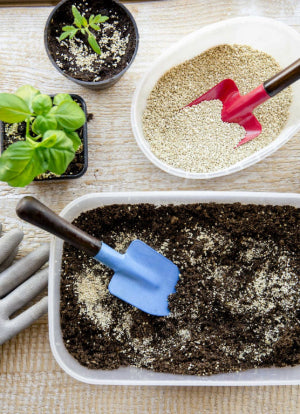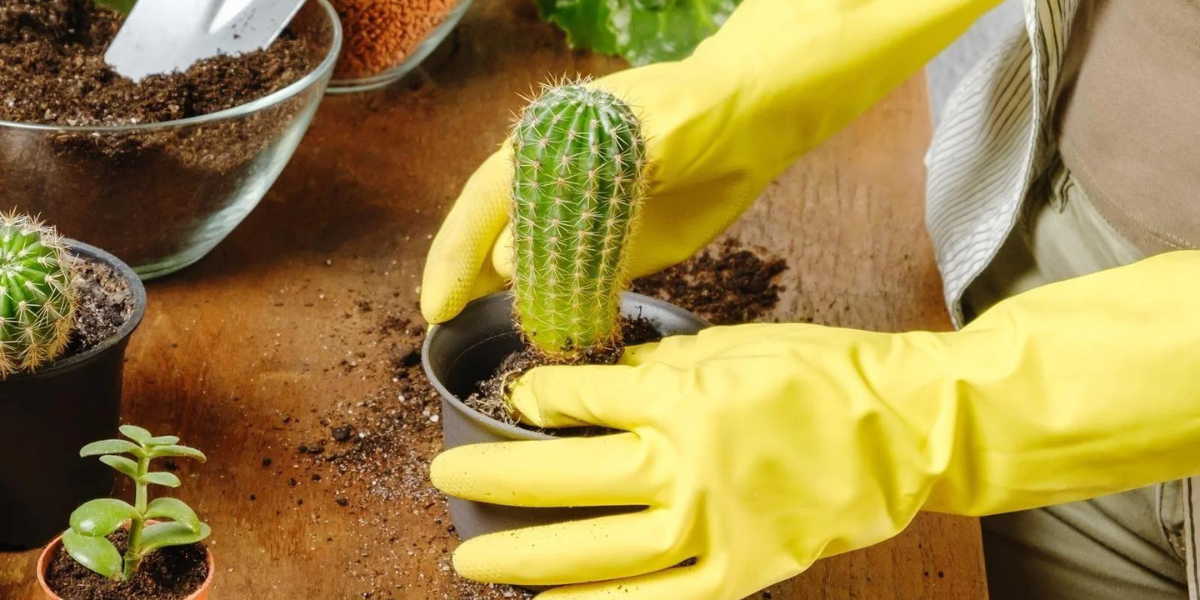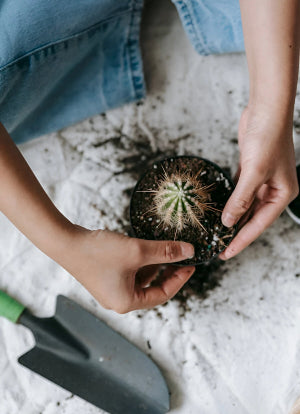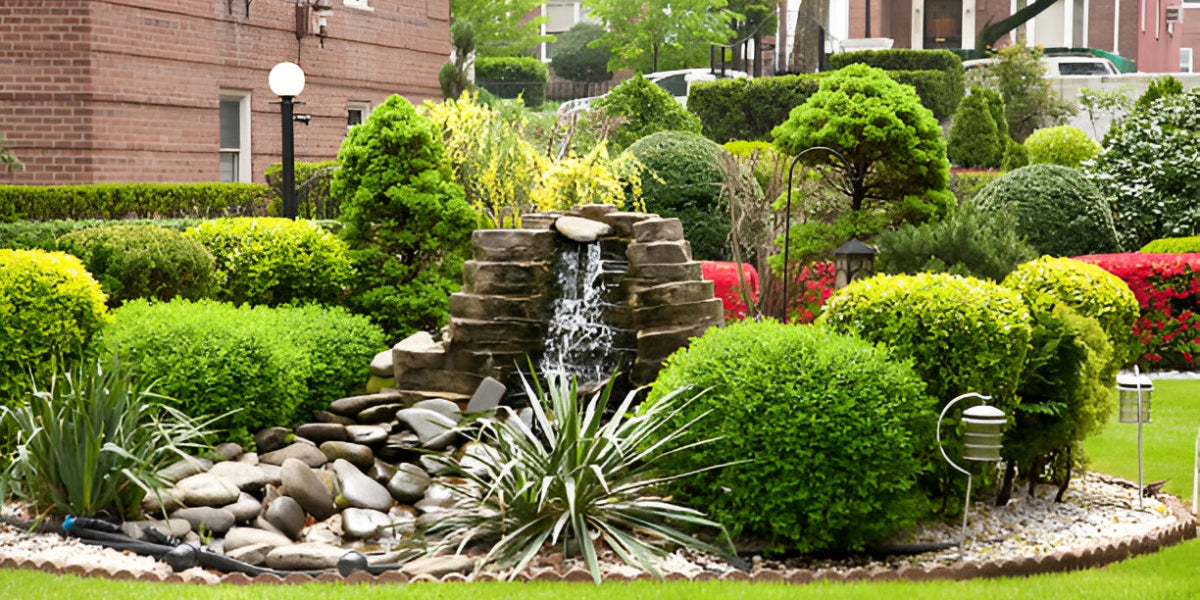Cactus Soil - The Ultimate Guide
Updated: January 28, 2025

C acti are stunning and make excellent indoor and outdoor plants, but they require a very specific type of soil that these plants thrive. When it comes to choosing the right soil for your adorable cacti, it’s like picking out the perfect outfit for a date - you want to make sure everything is just right later on.
Cacti need a special kind of soil to be happy and grow well. Here at Planet Desert, we grow over 500 types of cacti and have experimented with what works best. The best cacti soil mix has good drainage, is chunky, and allows extra water to drain away. If planted in an improper medium, they can swiftly perish because they are quite picky; so, you should be careful to use the right potting mix to keep your cactus happy and healthy.
So, in this article, we’ll tell you everything you need to know about cactus soil; including what it is, the best type, and how to make your own and how it differs from succulent soil and regular soil mixes.
What is Cactus Soil?
Cactus soil is a specialized mixture that is designed to meet the unique needs of cacti. It typically consists of a fast-draining medium of organic and inorganic materials.
- The organic components, such as pine bark, clay soil, and potting soil, help retain some moisture while providing a lightweight texture.
- The inorganic components, such as perlite, pumice, or coarse sand, improve drainage and prevent the soil from becoming waterlogged.
This combination creates an ideal growing medium for cacti, mimicking the well-draining conditions of their natural desert habitats.

Remember, Cactus soil is generally more neutral to slightly acidic (pH between 5 – 6.5) rather than alkaline. It is formulated to mimic the natural pH levels found in the desert regions where cacti thrive. This helps create an optimal growing environment for cacti. If your plants do not grow after 12 months in compost, it may be due to high pH water, causing soil alkalinity issues.
7 ingredients to avoid when Buying or Making your own Cacti Potting Mix
Making your own cactus soil has the main advantage of allowing you to mix the ideal mixture for both making plants happy and saving money.

Making your own in large quantities is far less expensive than purchasing it from a garden center. You are also in charge of all the ingredients.
Thus, you can be sure that they are safe and free of harmful ingredients (such as harmful fertilizers or chemicals that retain moisture).
However, if you don't want to go out and buy specialty ingredients just yet, I suggest choosing an extra gritty or organic commercial mix.
You can buy specially made cactus and succulent soil at a local garden center (or here at Planet Desert - Planet-Desert cactus Blend).
Much like when you’re shopping for food, you should check the ingredients on a bag of soil when you’re buying it. You’ll want to check to see if there are any organic matter or moisture retention additives as this can lead to root rot. While these ingredients are designed to hold water, it is essential to strike a balance as excessive moisture can lead to root rot and other fungal diseases. Therefore, it is recommended to use well-draining soil mixtures that allow excess water to escape easily, preventing waterlogged conditions that may harm the cactus roots.
Avoid these 7 ingredients as they are designed to hold water and can therefore damage desert-loving cacti species.
If you see any of these in the ingredients list, think twice before buying.
- Coconut Coir
- Bark shreds
- Vermiculite
- Manure
- Straw
- Compost
- Clay
If you want to go the extra mile and have a fantastic soil mix, you might want to blend your own!

DIY - How to Make your own Cactus Soil Mix?
Although nurseries and garden centers provide pre-made cactus soil mixture, you can make your own homemade cacti soil by following our directions below. It is a fun and cost-effective way to customize the soil for your cacti. Making your cactus soil mix is a great way to give your flowering plants the perfect growing or potting medium. Let's get started!
What You Will Need:
- Container or bucket: Use this to mix all the ingredients. A larger container makes it easier to blend everything.
- Measuring scoop: This helps you maintain the right ratios and ensures consistency in your soil mix. You can use any scoop or measuring cup you have on hand.
- Perlite: This lightweight material improves drainage and prevents the soil from becoming too compact. This perlite for cactus is commonly available at garden centers or online.
- Coarse sand or horticultural grit: Adding sand or grit to the mix enhances drainage and creates a gritty texture. Look for coarse sand or horticultural grit specifically, as they are more suitable for cacti and succulents.
- Low-nutrient potting compost: Opt for a potting mix specifically formulated for cacti and succulents. These mixes have a lower nutrient content, which is ideal for these types of plants that prefer low soil.
Remember, the goal is to create a well-draining soil mix that replicates the natural desert habitat of cacti.

Cactus Soil DIY Recipe – Step by Step Guide
There’s no universal answer to the succulent and cactus soil mix. Every plant’s needs are a little different and they come from different environments each with its unique soil characteristics. That being said, you can pretty easily mix up a blend that will work great for 95% of succulents.
There are many different soil recipes for different, but in general, you want a mix of lightweight materials that don't hold much water paired with a small amount of organic matter that will keep just enough moisture in the mix to keep it from completely drying out and solidifying. You probably already have the ingredients at home!
Here’s the secret quick DIY mix recipe:
-
Three parts potting soil – This can be any kind of soil, although you should stay away from compost-heavy mixes and the like. It’s okay if there is some organic matter since we will dilute it, but you don’t want to drown your succulent in peat moss. For any standard commercial potting soil works, we recommend you go with one of the ones marketed as succulent soil for a little extra boost.
-
Three parts grit – You could make an argument that perlite is grit or beach sand, and you would be mostly right. However, in this context, grit is used to mean other inorganic particles of varying sizes. You should include some small gravel chunks, large-particle sand (like builder’s or playground sand), or actual chicken gritty mix. These varying sizes help to break up soil and prevent compaction.
-
One part perlite or pumice – This is key. Perlite is a relatively large particle made out of volcanic glass. It’s “puffed” using the same heating process as puffed grain cereals, which introduces a lot of air pockets. Perlite encourages airflow in the soil, prevents soil compaction, and promotes drainage.
-
One part Pine Bark: Pine bark can be used as an ingredient in cactus soil to improve drainage and aeration. It helps to prevent waterlogging and allows excess moisture to drain away from the roots of cacti. Additionally, pine bark can add organic matter to the soil, enhancing its overall structure. When using pine bark, it's important to ensure that it is properly aged and free from any additives or chemicals that could harm your cacti.

Now, your DIY cactus soil mix is ready to go. Fill your pots or containers with this well-draining mixture, ensuring there are drainage holes at the bottom.
How to Use a Cactus Soil Mix?
Using the right type of soil is crucial for the health and growth of your cactus. Follow these guidelines to use your cactus potting soil correctly, whether you buy pre-made cactus soil or make your own at home.
1- Prepare your pot or container: Choose a well-draining pot with drainage holes to prevent water from pooling at the bottom. Fill the pot with about one-third of the cactus soil you just made.
2- Plant your cactus: Gently remove your plant from its nursery pot and loosen the roots. Place it in the pot, making sure it's centered and at the desired depth. Add more soil mix around the plant, filling the pot to about an inch below the rim.
3- Firmly but gently press the soil: Use your fingers or a small tool to lightly press the soil around the plant, ensuring it's secure and stable. Avoid compacting the soil too tightly, as this can hinder drainage.

4- Water sparingly: After planting, give your cactus a small amount of water to settle the soil. Be sure not to overwater, as cacti and succulents prefer dry conditions. Allow the soil to dry out between waterings.
5- Organic material should be replenished: This will help maintain a healthy balance of nutrients in the soil and promote the growth of beneficial microorganisms. Additionally, regularly adding organic materials can improve soil structure and water retention, leading to better overall plant health.
6- Place in a suitable location: Most cacti like golden barrel cactus can thrive 4-6 hours of bright sunlight a day. Find a spot with ample light and good airflow. Avoid placing them in direct sunlight for a long period, as it can scorch them. It prefers well-drained soil, so creating a small mound outdoors or hill can help with proper drainage.
Remember, the cactus is a great choice for xeriscaping, which is a landscaping method that conserves water. Its unique shape and beautiful spines make it a standout addition to any garden!
Can I Use Regular Potting Soil for Cactus?
Using regular potting soil for cacti and succulents is not recommended! Regular potting soil tends to retain moisture, which can lead to overwatering and root rot for these types of desert plants. Cacti soil is adapted to arid environments and prefers well-draining soil that allows excess water to flow through quickly.
Regular potting soil is typically formulated to retain moisture for plants that require more water. It contains organic matter that holds onto water, which can be detrimental to cacti that prefer drier conditions.
Cacti are fascinating because they have adapted to survive in arid environments. They store water in their leaves and stems, so they don't need frequent watering like other plants. They actually "drink" water from the soil and prefer it to be on the drier side. So, it's important to use well-draining soil specifically made for cacti and succulents to keep them happy and healthy!

Even some commercial cactus and succulent mixtures often contain ingredients that are too heavy and dense for indoor cactus plants. To lighten the mix, you might need to make one or more soil amendments or improve it by adding perlite, coarse, peat moss and horticultural grit.
To ensure the health and proper growth of your cacti and succulents, it's best to use a cactus-specific mix or the DIY mix outline above. These mixes are designed to provide excellent drainage, replicate the natural habitat of these plants, and prevent waterlogged conditions that can harm their roots.
How does Cactus Soil differ from a regular Garden Potting Mix- Top 5 Key Factors
Cacti make wonderful houseplants and may be cultivated indoors all year with proper care. Cacti, however, have different soil requirements than other plants, and normal potting mix or potting soil is frequently insufficient. Fortunately, most nurseries and garden centers have specialized cactus soil, and you can even make your own if required.
However, simply placing your cactus in a pot filled with sand won't guarantee a healthy plant. Here are some important facts about cactus soil and regular soil.
1- Cactus Require a Lower Moisture Content
Cactus soil and regular potting soil have distinct differences in terms of moisture content.
- Cactus potting soil is specifically formulated to have low water retention and excellent drainage properties. It is typically composed of a mixture of inorganic materials. These components allow excess water to quickly drain away, preventing the cactus from sitting in waterlogged soil, which can lead to root rot.
- While, regular potting soil is designed to provide a more balanced moisture environment for a wide range of plants. It contains a combination of organic matter like compost, peat moss, and vermiculite, which helps to retain moisture. This type of soil is suitable for plants that require more consistent moisture levels, as it holds onto water for a longer period.
2- Composition – Cactus Require more Sand & Perlite
- Cactus soil and regular potting soil differ in their composition. Cactus soil is typically a blend of materials that promote good drainage, such as sand, and perlite. These components help create a loose and well-aerated soil structure, allowing water to flow through easily and preventing waterlogged conditions that can harm cacti and succulents.
- On the other hand, regular potting soil is formulated to provide a balanced environment for a wide range of plants. It often contains a mix of organic matter like compost, peat moss, and vermiculite. These ingredients help retain moisture and provide essential nutrients for plant growth. Regular potting soil is designed to hold onto water for a longer period, ensuring that plants with higher water requirements have a steady supply.

3- Cactus Need More Aeration in the Soil
- Cactus soil is specifically formulated to provide good aeration for the roots of cacti and succulents. It typically contains materials like sand, and perlite which create air pockets within the cactus potting soil. These air pockets allow for the circulation of oxygen around the roots, preventing them from becoming waterlogged and promoting healthy root development.
- Regular potting soil also provides aeration, but the level of aeration may not be as high as that of cactus soil. Regular potting soil often includes organic material like compost and peat moss, which can compact over time, reducing the amount of air available to the roots. However, many regular potting mixes also contain additives like vermiculite or perlite, which help improve aeration and prevent compaction.

4- Excessive Nutrients Can Damage Your Cactus
- Cactus soil is typically formulated to have fewer nutrients compared to regular potting soil. This is because cacti and succulents are adapted to survive in nutrient-poor environments, so they don't require as many nutrients as other plants. Excessive nutrients can be harmful to cacti and succulents, leading to issues like root rot and overgrowth.
- On the other hand, regular potting soil is designed to provide a balanced amount of nutrients for a wide range of plants. It often contains organic matter like compost and peat moss, which can provide a rich source of nutrients. While this is beneficial for many plants, it can be too much for cacti and succulents, causing them to grow too quickly and become more susceptible to diseases.

5- Cactus Need a Soil that Drains Really Well
- When it comes to well-drained soil, both cactus soil and regular potting soil aim to provide good drainage, but there are some differences. Cactus soil has excellent drainage properties, as cacti and succulents are native to arid regions and are adapted to survive in dry conditions. Cactus soil often contains materials like sand and perlite, which help create larger pore spaces in the soil, allowing water to flow through more easily.
- Regular potting mix also aims to provide adequate drainage, but it may not be as well-drained as cactus soil. It typically contains a mix of organic matter like compost and peat moss, which can retain more moisture. While this can be beneficial for many plants, it may not be ideal for cacti and succulents, as they are prone to root rot if the soil holds onto excess moisture for too long.
What's the difference between cactus and succulent soil?
Cactus and succulent soil are both specially formulated to meet the unique needs of these types of desert plants. Succulent plants are similar to cactus plants in that they have developed mechanisms to cope with dry conditions, usually with fleshy, waxy-coated leaves: but only cacti can withstand the harshest desert conditions, so they are even more drought-tolerant than succulents.

The main difference lies in their moisture retention capabilities. Cacti soil is typically more well-draining, allowing excess water to quickly pass through, while succulent mix soil retains slightly more moisture to accommodate the specific requirements of succulents.
For more information you can visit our detailed article for succulent vs. cacti.
You see, the amount of moisture in the soil can make or break your little green friend. You've got root and stem rot faster than you can say "succulent." That's why we at Planet Desert have got your back with our specialized cactus potting mix.
Here at Planet Desert, we have been cultivating both cacti and succulents using our carefully crafted soil potting mix providing optimal drainage while retaining some moisture, creating the perfect growing environment. We are proud of our achievement and the success it has brought to our desert garden.
Best Cactus Potting Mix - Our Reviews & Recommendations
There seems to be some controversy about the best cactus and succulent soil combination. People have favorites, which is why this is. The best soil for succulents in pots retains just the right amount of moisture for them to absorb what they require, while also drying out quickly enough to prevent the roots from rotting. A top-quality cacti and succulent mix has good drainage, is chunky, and allows excess water to drain. We will mention here a very few of them:
Planet-Desert Specialized Soil Mix
The Planet-Desert Specialized Soil Mix is specifically formulated to meet the unique needs of desert plants. This perfect mix is designed to provide optimal drainage and water retention, with five natural substrates and organic mycorrhizae to promote the development of a strong root system that helps your cactus thrive and allows plants to thrive in arid conditions. Additionally, the soil mix contains essential nutrients and minerals that are crucial for the healthy growth of desert plants and the vigor of plants, resulting in vibrant blooms and abundant harvests. With our pre-mixed Cactus and Succulent soil Mix, you can instantly transform your home into a desert oasis!

Miracle-Gro Cactus Soil
Miracle-Gro soil is a specially formulated blend that is enriched with essential nutrients and minerals to promote healthy plant growth. Although this potting soil is designed to provide desert plants with optimal conditions for root development, moisture retention, and nutrient absorption, it may contain synthetic fertilizers and chemicals, which can be harmful to the environment and potentially affect the health of cacti over time. Additionally, some users have reported that the soil tends to retain moisture for longer periods, which can lead to overwatering and root rot if not carefully monitored.

Where to Buy Specialized Cactus Soil?
The Planet Desert specialized soil mix is one of the best soil for cacti that you can find online and purchase at the best prices. Planet Desert offers its cactus mix and ships it anywhere in the United States. You can also check out your local nursery, as they often carry a variety of cactus soil options. If you're looking to buy cactus soil near you, you can try searching for "buy cactus soil near me" using a search engine or a shopping app. This will help you find local stores or nurseries that carry cactus soil. Additionally, you can check out places like Cactus Soil Home Depot, which often has a selection of cactus soil available.

Final Thoughts
Overall, when it comes to choose the perfect cactus soil, the best option is a well-draining mix that provides good aeration for the roots. This type of soil helps prevent overwatering and root rot, which can be common issues for cacti. Using specialized cactus soil that is formulated specifically for these plants can be a great choice. It's designed to provide the right balance of moisture retention and drainage, promoting healthy root growth and overall plant development.
So, if you want to give your cacti the best chance to thrive, you can use our specialized cactus soil is definitely a good idea!
Do you have any questions about succulent and cactus soil? Do you need clarification on appropriate soil amendments? Even better, do you have a soil recipe you’d like to share? Tell us below in the comments.
Frequently Asked Questions
The best soil for cacti is a well-draining mix that allows excess water to flow away from the roots. A combination of organic and inorganic materials, along with perlite or pumice, creates an ideal cactus soil. This provides good drainage while retaining some moisture for the plants. Remember to avoid using regular potting soil, as it can be too moisture-retentive for cacti.
Cactus soil is generally more neutral to slightly acidic (pH between 5 – 6.5) rather than alkaline. It is formulated to mimic the natural pH levels found in the desert regions where cacti thrive. This helps create an optimal growing environment for cacti. If your plants do not grow after 12 months in compost, it may be due to high pH water, causing soil alkalinity issues.
Yes, you can definitely use cactus soil for other plants that have similar soil requirements. Cactus soil is designed to provide excellent drainage, which is beneficial for plants that prefer drier conditions.
However, keep in mind that not all plants will thrive in cactus soil, especially those that require more moisture or have specific soil needs. It's always a good idea to research the specific requirements of your plants before using cactus soil for them.
For the best soil mix for a Christmas cactus, you can use a combination of well-draining soil, such as a cactus or succulent mix. Ideally, you can use this practical recipe for dirt-free potting soil: 1 part succulent and cactus mixture, 1 part mix for orchids, and 1 part fine gravel, sand, or horticultural pumice with some organic matter.
This will provide good drainage while retaining some moisture for the Christmas cactus. Remember to avoid using heavy or compacted soil, as it can lead to root rot.
















